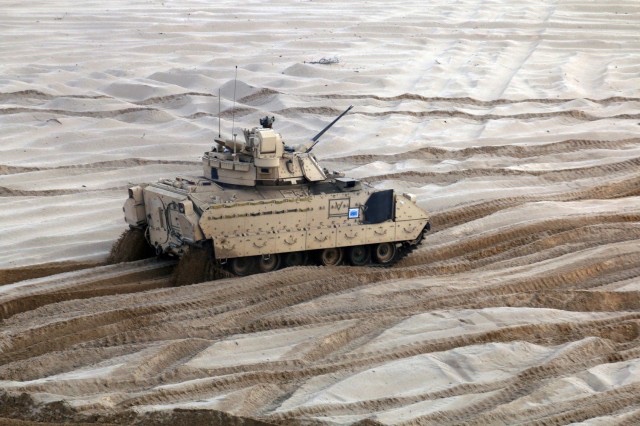
WASHINGTON — The Army’s Optionally Manned Fighting Vehicle program, now redesignated as the XM30 Mechanized Infantry Combat Vehicle, announced June 26 that a contract for prototypes will be awarded to two vendors: General Dynamics Land Systems Inc. and American Rheinmetall Vehicles LLC.
The two vendors will prepare prototypes of a vehicle to replace the M-2 Bradley Infantry Fighting Vehicle, which is a tracked vehicle designed for reconnaissance and provides protection, transportation and small-arms firepower for squad elements. The total award value for both contracts is approximately $1.6 billion.
“The XM30 will replace the Bradley fighting vehicle, bringing new transformational capabilities to the fight; these will include improvements to lethality, Soldier-vehicle survivability, and upgrade ability beyond the physical and economic limits of the Bradley,” said Honorable Douglas R. Bush, assistant secretary of the Army, Acquisition, Logistics and Technology. “The modular open system architecture that the XM30 will allow new building technology to be added to the vehicle as that technology matures, ensuring an overwhelming advantage in any potential adversary competition.”
The OMFV program is part of the Army’s modernization strategy. The Next Generation Combat Vehicle program aims at updating several vehicles and weapons platforms used in the Army today.
Part of advancing and modernizing the Army is seeking out the best designs through competitive contracts.
“Competition remain a vital aspect of the XM30,” Bush said “The program opened the door for industry partners that are not traditional U.S. combat vehicle prime contractors, which allows for increased competition and innovation. This reduced the Army’s risk and increased our likelihood of success while balancing investments across the entire Army modernization enterprise.”
The Bradley first started being used in 1981 and is an infantry fighting vehicle used to transport infantry on the battlefield as well as provide support to dismounted troops. It has been updated over the years but has reached its technological limits.
“In recent years, peer and near-peer competitors of the United States have significantly increased their combat vehicle capabilities. The character of warfare has changed, and our potential adversaries are bringing increased value to the battlefield,” said Brig. Gen. Geoffrey Norman, director of the next generation combat vehicles.
Concerns over the impact to the effectiveness of an outdated vehicle during full-spectrum military operations was what gave rise to the decision to modernize the Bradley.
“The best way to respond is to ensure that our formations are equipped with infantry fighting vehicles, which can bring greater survivability, powerful lethality at standoff range and improved maneuver capabilities to the battlefield,” Norman said.
Even though the XM30 hasn’t yet been designed, several key features have been outlined for the vendors to include in their prototype: two Soldiers to operate and carry capacity for six more, a 50mm cannon and a remote turret, as well as anti-tank guided missiles. Weapons systems on the XM30 will be designed to use the latest in sensor and fire control systems.
The XM30 will also be designed with sustainability and mobility in mind as it will feature a hybrid electric powertrain, which will reduce power consumption, Norman said.
“The occupants will benefit from innovative force protection systems that include integrated active protection systems, kitted armor and innovative signature management capabilities from the very beginning,” Norman said. “All of these advances are being designed with modern digital engineering in a modular, open systems approach that will allow for rapid integration of the latest hardware and software in the future.”
“The XM30 meets the Army’s requirements for a transformational increase in warfighting capability, not simply another incremental improvement over the Bradley fighting vehicle,” Norman said.
A modernization effort is planned to replace the M-113 Armored Personnel Carrier and M-1 Abrams Tank, as well as development of a light tank for infantry brigade combat teams. There are also plans for three versions of robotic combat vehicles.
By SFC Michael Reinsch, Army News Service

